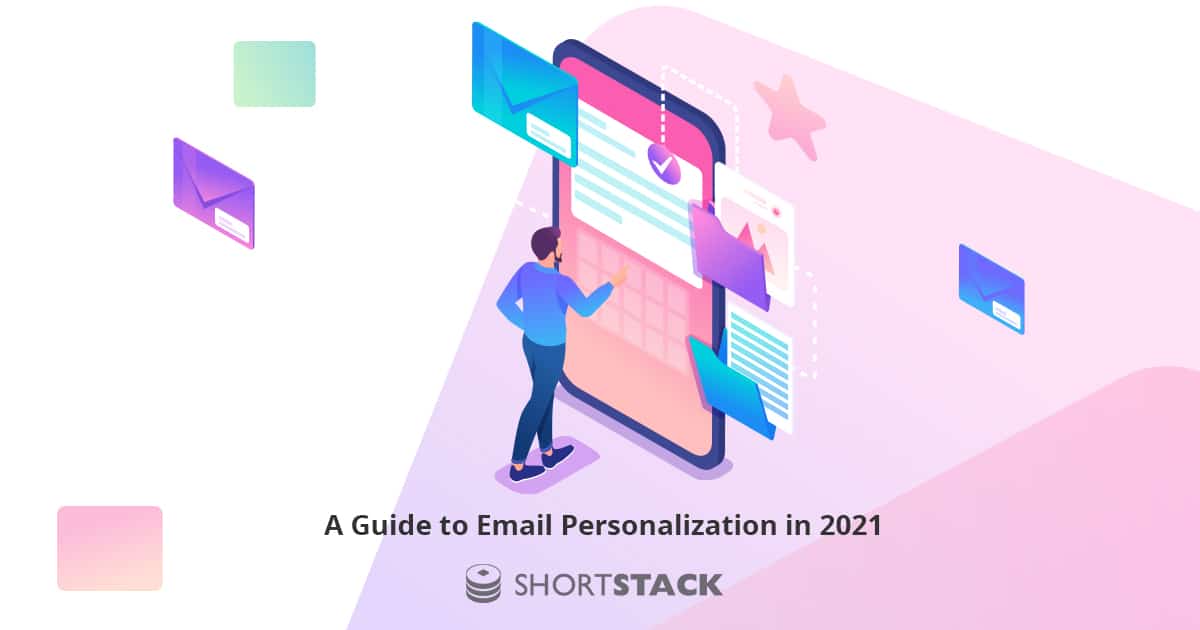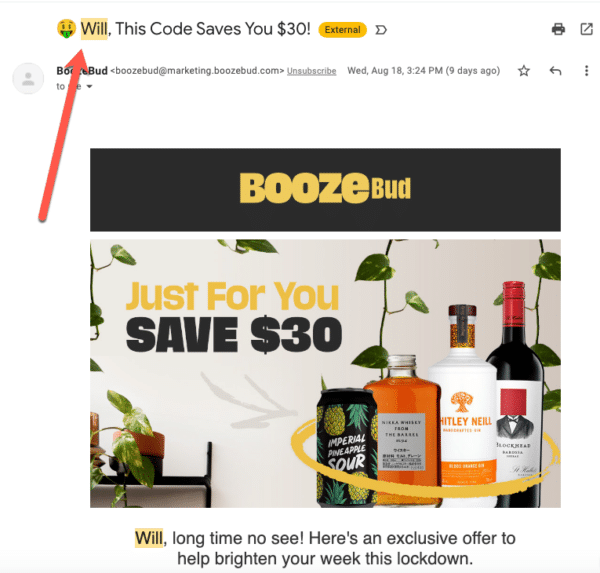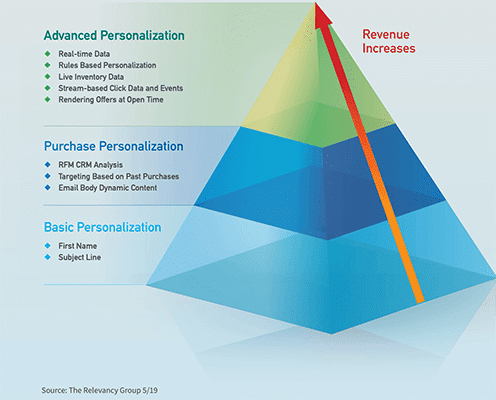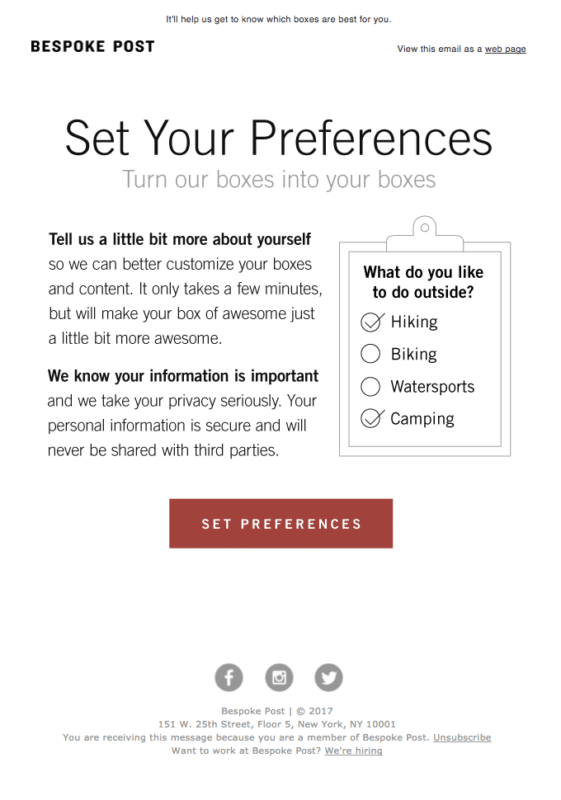A Guide to Email Personalization in 2021

Discover how email personalization has evolved in 2021 and learn effective ways to personalize your email marketing campaigns.
Personalized customer experiences have become the new norm.What was once an exciting (and sometimes freaky) run-in with a retargeting ad or product recommendation, is now a ubiquitous trend with businesses of all shapes and sizes.In fact, 66% of consumers expect brands to understand their individual needs and deliver personalized content accordingly. Not to mention 80% of people are more likely to buy from a brand that provides a personalized experience. Email is a key part of the marketing personalization ecosystem.But how has email personalization evolved in 2021? Let’s find out.
Ways to Personalize Emails in 2021
Email personalization is hardly a new phenomenon. The <Insert First Name> field has been used for as long as I can remember.So, it’s safe to say that your business is personalizing email content even at the most basic level - such as using someone’s name in a campaign.What other ways is personalization being used in email marketing? Well, there are numerous “Basics” to email personalization that you may already be using. Then, there are some more advanced strategies that are worth considering in 2021 and beyond.
The Basics
Email personalization doesn’t need to be overly complex. Starting with the basics makes sense, or you might bite off more than you can chew.
- Subject lines - It’s reported that personalized email subject lines improve open rates by 26%. The most common form of subject line personalization is to use a receiver’s name, but you may use other data such as location, interests, or recent behavior. Here is a simple example from my inbox:

An example of a personalized email subject line
- Contact segmentation - By segmenting your database, emails naturally become personalized. For example, you could create segments for age groups, time zones, geography, interests, purchase history, and more. By using your knowledge of each segment and its characteristics, the emails you send will come across as personalized. Of course, the narrower your segments, the more personalized the emails will feel to each individual.
- Automated email sequences - Drip sequences are typically triggered by a user event - such as someone subscribing to your newsletter. While this type of marketing automation might seem impersonal, by nature, if you create a variety of sequences based on user input and behavior, it can actually appear highly individual. Most CRMs and email marketing tools allow you to create automation with an “If This Then That” workflow so that users only get emails based on their previous activity.
Advanced Personalization
The basics of email personalization are a great starting point, but these advanced tactics will take your return on investment to new heights. It’s estimated that brands who use advanced personalization tactics see a 20:1 return.

A graphic showing the influence of personalization on revenue Here are some examples.
- Product Recommendations - Utilizing recent customer purchases or browsing history to recommend similar or complementary products is a powerful personalization tactic to encourage up-sells and cross-sells, increasing the lifetime value of a customer. Netflix uses a similar concept to recommend streaming content to its customers:

Netflix email personalization example
- Targeted Discounts - 90% of customers are willing to share personal data to receive exclusive discounts on products they’re interested in. The trick is turning these discounts into truly personalized events, rather than catch-all promotions. Some examples of targeted discounts include cart abandonment incentives, automated “refill” emails for perishable products, birthday offers, and version upgrades for current customers. Hush Puppies uses a targeted discount to engage with a specific segment of customers in this email:

A personalized email from Hush Puppies
- Emails Triggered by Behavior - You could set up a series of automated email sequences based on users' behavior. For example, if they view a product page on your website but don’t make a purchase, why not follow up with an email explaining the product’s key benefits? Website activity is one of many behavioral triggers you can use to personalize your email marketing strategy. This email from UNIQLO is a great example of a personalized email triggered by behavior:

Triggered email from UNIQLO
- Dynamic Content - It's possible to change the content in emails based on predetermined criteria dynamically. To make an email more relevant, you can change images, offers, URLs, copies, products, and more. Say, for example, you sell pet products, you could switch out the images and calls-to-actions used for an email campaign so that your "cat lover" and "dog lover" audience get appropriate messages.
How to Personalize Emails Effectively
All of these ideas for email personalization sound great, but how do you execute them? It all comes down to three critical elements; data collection, behavior tracking, and personalization tags.
Data collection
You can’t personalize emails without data - it’s as simple as that. Even if you're only personalizing a user's first name at the beginning of an email, you are unable to do so without that information.The best brands are collecting data at every opportunity possible to create a holistic view of their customers. It all starts with your website and landing page forms. The first time someone signs up to your email list makes a purchase on your website, or reaches out with a question is crucial in the data collection journey.What information will you get from them? Name? Email? Phone number? Something else?The more information you ask for, the lower your conversion rates will be. So it’s a balancing act. With testing, you can find a level of data capture on the first instance that optimizes conversions without decreasing the quality of your data - allowing you to then personalize communication with each individual.ShortStack’s Form Designer makes it easy to design and build data collection forms for your landing pages. It has a lengthy list of standard fields and you can also create custom fields to collect any data you want:

ShortStack's Form Fields[button size='medium' style='white' text='View and Create Your Own' icon='' icon_color='' link='http://hashtagfeedgiveaway.www.shortstack.com/1MPMXc' target='_blank' color='' hover_color='' border_color='' hover_border_color='' background_color='' hover_background_color='' font_style='' font_weight='' text_align='' margin='0 0 10px'] Of course, once someone has completed a form and is part of your database, you can collect more data by asking for subscriber preferences, and tracking activity. Just like in this email from Bespoke Post:

Example email asking for customer preferences
Behavior tracking
As well as manual data collection - where the user physically tells you something about themselves - you can also track their behavior to get to know them better.When I talk about behavior tracking, I’m referring predominantly to website pageviews and on-page actions. Most email marketing software will let you install a tracking pixel on your website that tracks a user’s activity and allows you to trigger automation or personalize email campaigns based on the data.Another form of behavior tracking is to analyze how users interact with your email campaigns. For example, you could segment your audience based on the topic of emails they engage with, or you can score users on their general level of activity, to personalize the type and amount of communication you have with them.All forms of behavior tracking will arm you with additional data about users and help you personalize your marketing campaigns.
Personalization tags
Email personalization tags are the key to list segmentation. While you could segment your database manually each time you need to run a campaign, it’s much more effective to do this automatically using tags.A tool such as ActiveCampaign has over 30 pre-set personalization tags you can use to label individuals in your database - including fields such as name, organization, phone number, and more. You can also create “custom tags” to label and categorize contacts based on any criteria you need.For example, if a user views a buyer’s guide on your website about “The Best TVs,” opens an email about your best-selling TVs, and then visits a product page in the same category - you could tag them as “Interested in TVs.”This is a fairly basic example, but you get the point. The beauty is you can set up custom workflows for automatically tagging users based on this activity. If needed, you can also automatically remove a tag when it is no longer relevant - such as a purchase event.
Conclusion
Email personalization is more important than ever. Without at least a basic level of personalization, your campaigns won’t reach their potential and you’ll limit the growth of your business.The good thing is, with improvements in email marketing technology, adopting even advanced forms of personalization isn’t super complex. Brands of all shapes and sizes can join the party.




